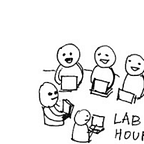On Image Averaging and Facial Recognition
On Monday, Zach Lieberman taught us about facial recognition and facial averaging. During class, we focused on studying works by Nancy Burson and Jason Salavon. Nancy Burson is known for her work in facial morphing technologies, which are used to help locate missing children and also to create art pieces that transform faces into other likenesses. Jason Salavon has used image averaging approaches to visualize large sets of related images in ways that produce new ethereal works or allow the viewer to interpret more general themes about their context. We also discussed the critiques of works that use facial averaging or morphing to reify physical boundaries between race and gender.
Zach also taught us about how to use the openFrameworks addon ofxFaceTracker2 to find faces and facial features in images and video. Afterward, Zach did a special workshop on using shaders to create interesting effects in openFrameworks with GLSL.
Branding Blackness
On Tuesday, we covered the chapter titled “Branding Blackness” in Simone Browne’s book Dark Matters: On The Surveillance of Blackness. This chapter explores a history of branding the Black body to help inform a more critical understanding of how biometric surveillance technologies are used to brand us today. Browne discusses how biometric surveillance technologies are also positioned as neutral to hide their inherent focus on targeting specific groups of people.
During the lecture, our teacher American Artist used quotes from the text and additional narration and imagery to explain concepts such as epidermalization (the inscription of race onto the body), scientific racism, and commodity racism. In our group discussion, we explored how popular sci-fi films have contributed to shaping our consciousness about the use of biometric technologies, and how our ability to form a digital identity is often hinged on our submission to comprehensive digital surveillance.
Learning Arduino
Wednesday was our first Hardware class with Che-Wei Wang of CW&T. We learned about Arduino, an open-source, programmable microcontroller platform. During class, Che-Wei walked us through the typical components on an Arduino board, some example projects that use them, and how to program an Arduino using the Arduino IDE. We also learned about how to use openFrameworks to interface with the Arduino.
I personally appreciated our deep dive into serial communication. During the lecture, Che-Wei discussed how to use the Serial Monitor to read from and write to the Arduino. We also used the Serial Plotter to visualize capacitive sensor readings. To help anchor or understanding even further, we also had a high-level conversation about the Arduino’s use of serial buffers.
Later that day, SFPC hosted a family dinner–a weekly event where students, teachers, and friends come together for dinner in the SFPC space. Taeyoon Choi led us through a CPU Dumplings workshop, which uses the process of making dumplings to help explain how computers work internally. Not only does this yield a better understanding of computer components, such as the CPU or ALU, but it also produces a lot of tasty dumplings!
Collages and Effects
In Scrapism class, our teacher Sam Lavigne taught us about how to scrape images from Shutterstock with Python. We then used ImageMagick CLI tools to convert these images into collages and GIFs. ImageMagick also contains some tools for adding effects, such as color inversion or kaleidoscoping, to images as well. By the end of the class, we had created a robust Python script for scraping images and applying ImageMagick effects to them automatically with subprocess calls.
Movement and Artist Statements
Friday began with a high-energy Movement workshop led by Cori Kresge. The class focused on embodying movements at the intersections of real, imaginary, external, and internal experiences. Class started inside with a brief meditation that quickly transitioned into a dynamic exercise oriented around moving energy into different parts of the room. We later went outside to create movements based on sensory observation of our surroundings and our imaginations.
In class, Taeyoon Choi guided us through a group review of our artist statements. During the class, Taeyoon read each of our artist statements aloud to the class and asked other students to provide feedback. We went in depth into the language of the statements–working to reveal areas of missing clarity.
This was an extremely useful exercise for improving our statements, as well as a great way to learn more about the intention we each place behind our work. I also found this to be a great way to encourage our peers. We used this exercise as a way to encourage more confidence in our peers and share our positive thoughts about their practice and personality.
